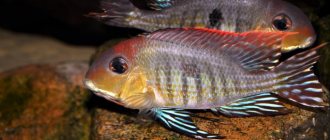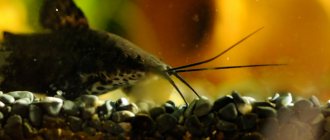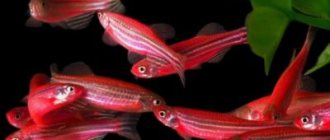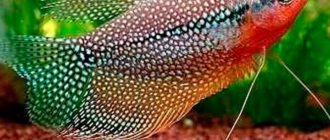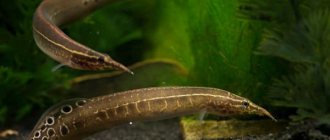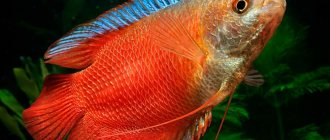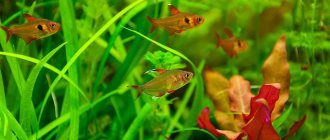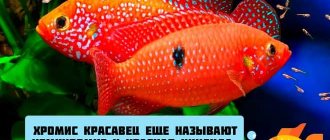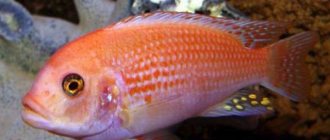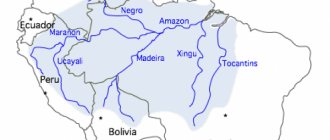Maintenance and care, arrangement of the aquarium
The optimal size of an aquarium for one adult fish starts from 200 liters. The design is recommended to recreate conditions reminiscent of the natural habitat - a river bottom with a slow flow of water with a sandy substrate and an intricate labyrinth of tree roots and branches. Lighting should be dim. If you plan to use living plants, you will need to select shade-loving species that can attach to the surface of driftwood. Any vegetation that takes root in the ground will soon be dug up. A layer of leaves from some trees will complete the design. They will not only become part of the decor, but will also allow you to give the water a chemical composition similar to that in which Ancistrus vulgaris lives in nature. As the leaves decompose, they will begin to release tannins, particularly tannins, which turn the water brown and help lower pH and dGH values. Read more in a separate article “Which tree leaves can be used in an aquarium.” Like most other fish that come from undisturbed natural habitats, they are intolerant of the accumulation of organic waste and require impeccable water quality. For this purpose, regular aquarium maintenance procedures are carried out and a productive filtration system and other equipment are installed.
Care and maintenance
The catfish stuck almost all day long searching for and eating new food. Thus, it fights algae and food debris in the aquarium. He does this with the help of his suction cup. Inside the aquarium, they rarely reach a size larger than 15 cm. Despite their usefulness, they do not look so attractive to many: a suction cup mouth, dark color, mustaches near the mouth.
Ancistrus catfish (Latin name ancistrus dolichopterus) likes to hang upside down or hide under all sorts of objects, so it is very good to add ceramic pots, large driftwood, and coconuts to your aquarium. By the way, adding driftwood to an aquarium can not only provide shelter, but also be beneficial for their digestion. The fact is that wood contains lignin, by scraping which fish improve their digestion. The cleaner catfish actively eats leftover food, but at the same time actively excretes waste products, so it is advisable to install a good filter in the aquarium.
As stated above, catfish are rightfully considered one of the most resistant species; Ancistrus requires minimal maintenance and care, and you really need to try hard to ensure that the aquarium conditions do not suit it. But let’s give an approximate characteristic that will be most favorable for him:
- Water parameters: pH 6–7.3 dH up to 10°, KH up to 2°, water hardness no more than 20–25 dH;
- Water temperature: 20–26 °C (ideal 22 °C).
They love clean water with a lot of oxygen, so don’t forget to change it periodically and also provide aeration. An interesting observation is that sucker catfish are larger in size, as a rule, the lower the water temperature.
What to feed Ancistrus
Sticky fish love to eat, but in addition to leftover food, they will gladly eat:
- plant foods based on spirulina (can be found in tablets, they dissolve well in water and attract with their smell);
- frozen food (bloodworm or coretra);
- vegetables (scalded pieces of zucchini, cucumbers, spinach, peas, pumpkin or lettuce, cabbage);
- tubifex worms, insect larvae, daphnia, cyclops or other worms.
To avoid contaminating the water, be sure to remove any uneaten remains. In general, catfish adhere to lovers of plant food, but when there is a lack of nutrition, they switch to a live diet. 70–80% plant foods and 20–30% protein are recommended. Follow the rule that food should not be monotonous; food should be both live and dry.
Due to the fact that sucker fish are quite active, they require quite a lot of space, so the aquarium should be spacious. For a couple (male and female), the recommended aquarium volume is 80 liters or more. Of course, they can be kept in smaller volumes, but most often the fish in a smaller volume dies. With proper care, aquarium cleaners live quite a long time. Ancistrus live 6–8 years, although sometimes they live longer, for example, up to 12.
Description
In nature, it reaches a length of 15 cm or more, but aquarium catfish are usually about 13 cm. The body is elongated, flattened, teardrop-shaped, the back is covered with rows of bony plates.
The head is wide, flat and large, and the male Ancistrus has numerous antennae. The body has a pair of wide, even voluminous, pectoral and ventral fins. The mouth is in the form of a huge suction cup, equipped with a powerful “grater”, which allows you to process and eat even the smallest, corrosive algae. Therefore, the Ancistrus fish has other names, such as sucker catfish and sticky catfish.
The dorsal fin is sail-shaped, which, when not moving, is tightly pressed to the body. The body of the fish is usually olive-brown with white speckles. The abdomen is light. But the color can vary from yellowish to almost black. Even in one litter of fry there is no uniformity: 2-centimeter babies are brown, gray, and speckled. And adult common ancistrus are colored differently - plain brown, black, and the albino form is pink or yellow, and speckled with light specks on a brown or black background. In nature, common ancistrus, even taken from neighboring streams, can look different.
The life of ancistrus lasts 5-6 years, although in nature the fish die before reaching old age.
Habitat in nature
Its natural habitat is the majestic waters of the Amazon River basin in South America. Catfish prefer to settle in fast-flowing mountain rivers, but are often found in lakes and even swamps. Under natural conditions, the fish, using a modified mouthparts, attaches itself to snags or huge boulders, gradually “cleaning” everything edible from the surface.
An important condition for the habitat of ancistrus is the presence of a fast current and oxygen-enriched water.
Size
Adult male ancistrus can reach 14 cm, but are usually half that size. The male differs from the female by the presence of bushy “horns” on the nose, which are soft skin outgrowths. Females are slightly plumper, and the growths on the nose are almost invisible.
Body Shape
Ancistrus have a teardrop-flattened body shape with a wide head. The anterior rays of the pectoral and anal fins are greatly thickened and covered with small spines, and the body is covered with rows of wide bony plates.
At the base of the head there are hidden spines, which, when danger approaches, spread out in all directions. In wildlife, these spines are used not only during conflicts, but also for more convenient attachment to obstacles in strong currents.
Behavior
Catfish have a calm character and a neutral attitude towards other inhabitants. But among a large flock of Ancistrus, fights occur among males. They are territorial and protect occupied territories. When keeping one male ancistrus and a flock of several females, there is no conflict.
The golden catfish Ancistrus is active at dusk, and during the day it hides in shady places.
Color
The main color of ancistrus ranges from light gray with a yellowish tint to dark gray with light specks. However, the color of this fish changes easily depending on its mood, usually changing to pale.
Character
Star ancistrus are peaceful and shy catfish that prefer a nocturnal lifestyle. During the day, unsociable fish hide in shelters and can freeze in one place for hours. They camouflage well. Skirmishes happen within a species. Newly acquired individuals are shy, but, having gotten used to it, they often come out of hiding and eat during daylight hours.
Lifespan
Ancistrus catfish lives on average 10 years.
Ancistrus and its compatibility with other fish
If we talk about how the ancistrus will get along with other fish, then dry statistics come into play - it will get along perfectly. Is it with all the fish? Unfortunately, no, and let's look at why.
Ancistrus can be dangerous for large, slow-moving fish that lack scales. Crawling over a large object, without any malicious intent, catfish can damage the skin of fish.
But not only danger can come from ancistrus. Large cichlids are dangerous enemies of our cute catfish. There is a suspicion that cichlids that build nests on the bottom regard ancistrus as a potential threat to encroach on their nests, and this is already a reason to attack. Try to avoid the proximity of large aggressive cichlids to Ancistrus. Even their chain mail armor may not save the latter.
Compatibility
Ancistrus are one of the most peaceful fish that are compatible with almost any type of ornamental fish. They can be kept without problems with both small schooling fish (neons, tetras, barbs) and medium-sized cichlids.
Usually, even relatively large and aggressive fish do not touch ancistrus. Not the least role in this is played by the dense “bone” shell and the presence of spines on the pectoral fins. In addition, ancistrus are rather sedentary fish, and spend most of their time hidden in shelters, from which it is very difficult to get them out. However, you can often find information that ancistrus can attack some fish and even leave wounds on their bodies with their powerful jaws. Therefore, sometimes it is not recommended to keep them with slow-swimming species, for example, selective forms of goldfish.
Ancistrus catfish can be kept in aquariums with live plants, provided that they receive a sufficient amount of food with a plant component. Otherwise, the delicate parts of some plants may be damaged.
Diseases of catfish
When buying fish, many people do not even suspect that their pets can get sick. Identifying the disease in catfish can be problematic, because the fish are nocturnal and rarely swim out for public viewing in daylight. Ancistrus may experience a number of health problems:
- White spots on the fish's body may appear due to stress. In this case, we are not talking about illness, but about stress staining. In a stressful situation, ancistrus become dull and partially lose pigmentation. This can happen when transplanting a catfish from a familiar container to another aquarium, as well as after transportation. The infectious disease in the form of white spots can be carried by other fish. Therefore, after acquiring new neighbors for the catfish, they must be kept in a quarantine tank for at least 2 weeks. If the color of the catfish has changed and spots have appeared, it is also isolated. Quarantine and treatment last for at least 14 days. For treatment, purchase the drug Antipar.
- Ichthyophthiriasis resembles a scattering of semolina on the body of a fish. The disease is caused by the ciliate ichthyophthirius. For treatment, potassium permanganate, copper sulfate, malachite greens and formaldehyde are used. These substances can lead to the death of algae and invertebrates inhabiting the aquarium.
- Velvet disease or oodiniosis may not manifest itself for a long time, but under unfavorable conditions (stress, changes in water parameters) it will begin to progress. Sick individuals are characterized by reduced activity. Their fins turn into fragments of sharp rays, on which there is no interray tissue. The fish's skin will begin to peel off, and the body will resemble velvet fabric. Without treatment with antibiotics, the disease cannot be controlled. For 100 liters of water you will need 1 bottle of Bicillin-5. On the second day, perform a partial water change (30%) and repeat the administration of the drug. After 48 hours, the treatment is repeated, a control administration of the drug is carried out a week later. The treatment is considered effective, but the algae die.
- With chilodonellosis, cloudy areas of a bluish tint appear on the sides and back of the fish. It is necessary to examine the caudal fin if it is tightly compressed but not disheveled - this is a sure sign of disease. Levomycetin is used for treatment. For 100 liters of water, 3 g of the drug is needed. The product is added 3 times, maintaining 48-hour intervals. Before adding the dissolved drug, the water in the aquarium is replaced by 1/3. Additionally, you can raise the temperature in the aquarium to +28-30°C and add 3 tbsp to the water. salt. But such an additive will contribute to the death of algae.
- Dropsy is hard to miss. The catfish's belly swells and it stops defecating. For treatment, it is necessary to remove the sick individual and add Levomycetin (75 ml/l) or Ciprofloxacin (50 ml/l) to the water. The water temperature must be at least +27°C. Treatment is carried out for several days in a row. Effectiveness is indicated by a shrinking belly and the appearance of bowel movements.
From the editor: Aquarium for beginners!
Ancistrus starata is a good choice for a freshwater aquarium. The peaceful existence of the catfish with other fish will allow it to rationally fill all layers of the home pond.
Conditions of detention
Ancistrus catfish are very unpretentious; even beginners can handle them. Since the fish is very active, the aquarium must have a volume of at least 80 liters per catfish. A comfortable temperature for ancistrus is +22–26°C, but catfish can easily withstand changes from +18 to +30°C (although it is better not to experiment with this, because such stress may well be fatal for the fish).
In nature, ancistrus prefer slightly acidic water (6.0–7.3 pH), but in an aquarium they are less picky and survive in any conditions. The only mandatory factor for this fish is constantly clean and oxygenated water. For this purpose, air filters are installed, and the water is changed frequently.
Ancistrus catfish lead a predominantly twilight lifestyle, so constant bright lighting is contraindicated.
It is worth installing calm, low and dim lighting in the aquarium. In addition, the catfish themselves become more active in the evenings.
Nutrition
Keeping ancistrus and caring for these catfish requires the correct choice of food. The basis of nutrition is plant foods, which need to be diversified with other types of food. Organizing the nutrition of ancsistrus is very simple. These catfish are very good at eating algae and plant growth in densely overgrown aquariums.
Algae are the basis of the diet of ancistrus
It is no secret that the Ancistrus fish is purchased by many aquarists for a specific purpose - as an aquarium cleaner. Indeed, catfish make characteristic jumping movements along the glass walls of the aquarium and across all decorations in search of surfaces overgrown with algae. As soon as they find a suitable place with a lot of fouling, they instantly suck on their mouths and begin vigorously scraping off their favorite food - soft green algae.
If there is little algae fouling, then they begin to eat the plants planted in the aquarium. Young leaves get the worst of it: either they are eaten whole, or catfish gnaw holes in them.
In terms of their ability to eat algae and aquarium plants, ancistrus occupy a leading position among herbivorous fish.
But this food is only part of the diet needed by catfish. What else is included in the menu of these fish?
Driftwood is food for ancistrus
The nutrition of ancistrus must necessarily provide them with components such as cellulose and legnin. They are necessary for good digestion of plant foods and for maintaining normal fish health. Therefore, it is very important to place a good, specially prepared driftwood in an aquarium with ancistrus. And you, of course, will notice how much time your pets will spend on it, gnawing it.
Where to get driftwood: buy it in a store or find it in nature. These should be hard trees (willow or oak), but not coniferous. The snag must be soft, like rotten wood.
If you go in search of natural driftwood, go to bodies of water. The best option for driftwood is the one that is removed from the water: it is already saturated with water and therefore heavy, it will not float. It must be subjected to additional processing - boiled in salted water for several hours.
More options for natural driftwood:
- Old tree roots hanging into the water.
- Driftwood found at the bottom of drained lakes (catfish eat them almost completely)
Greens and vegetables
Above we discussed the danger of catfish eating aquarium plants. To avoid this, it is important to give ancistrus different foods of plant origin. For example, lettuce leaves are first dipped into boiling water for a minute. Cabbage and nettles, processed in the same way as lettuce leaves, are tied to a weight and dropped to the bottom.
Don’t forget to remove any uneaten remains of plant food from the aquarium after 24 hours to avoid rotting and subsequent poisoning of the fish.
Ancistrus are very willing to eat other plant foods: zucchini, pumpkin, carrots.
Live food - addition to the diet
A mandatory addition to the diet of Ancistrus catfish is live or frozen food. They are very fond of the tubifex and bloodworms.
Remember about the peculiarities of the structure of the oral apparatus of catfish - suckers! Offer them only live food that they can take from the bottom.
There is no need to overfeed with bloodworms and tubifex, as this can cause the death of the fish. It is better to give preference to frozen food of animal origin - their safety level is higher, because the processing process contributes to the death of microorganisms.
Ready-made feed
Stores sell special ready-made food for ancistrus. These are a variety of flakes, granules, tablets. When purchasing food, be sure to make sure that the food will quickly sink to the bottom of the aquarium (ask the seller about this). After all, ancistrus, like many other catfish in the water column, will not be able to catch food. Ready-made food from leading manufacturers is balanced in composition and can provide your pets with a full range of essential nutrients. This is especially true for beginner aquarists who do not have much experience in selecting food for fish.
In the diet of ancistrus, up to 80 percent should be plant foods and only 20-30% should be protein foods.
Water composition
The properties that water must have for a comfortable life of ancistrus do not differ in special requirements:
- Acceptable water temperature is 20-28°C
- The acidity level ranges from 6 to 7.5
- Water hardness should not exceed 20°
Water changes should be carried out every week and amount to one third of the total volume.
Minimum aquarium volume
The veiled ancistrus is a fish for which the volume of the aquarium is of paramount importance. The ease of caring for catfish often leads to the fact that people do not think about the size of the container, and keep ancistrus in twenty- or thirty-liter aquariums. This causes a lot of unpleasant consequences: the fish cannot grow normally, they dry out, and so-called stress spots appear on their body, which mean loss of pigment. They become more susceptible to a variety of diseases, including infectious diseases. In order to avoid such problems, you should make sure that there is at least eighty liters of water per two ancistrus.
Plants
You don't need a lot of plants, but a few plant covers are advisable. The relationship of star catfish to plants varies. Ancistrus sometimes damage tender plants, especially Echinodorus and Schisandra, even if the diet includes a sufficient amount of herbal supplements. In some cases, fish are kept in herbal gardens, where the plants remain unharmed. Secure the roots by pressing them with a stone or attaching the plant to a piece of driftwood, then the catfish will not dig them up. Suitable for keeping with Ancistrus:
- Anubias;
- Vallisneria;
- Java moss;
- Cladophora;
- duckweed.
Diseases
Ancistrus catfish are not in poor health, but some diseases also affect them. A common cause of disease is failure to maintain cleanliness and hygiene of the aquarium, untimely change of water, and rotting of food particles stuck between stones. Therefore, the best prevention of diseases in the aquarium inhabitants is timely cleaning and replacement of water.
In order to promptly determine the deteriorating health of ancistrus, you need to monitor the condition of your pets every day. If you recognize the disease in advance, it can be easily cured.
Symptoms of a sick catfish:
- Unusual behavior, uncharacteristic actions. Sluggish and inhibited or overly active behavior in combination with other symptoms indicates some kind of disturbance in the body.
- Change in fish color. More often the yellow color fades and loses its brightness. But this also happens after the spawning process, so this symptom is inaccurate.
- Poor appetite or its complete absence. Healthy fish are always ready to feed and swim to the place of food. And the patient remains in the shelter and does not touch the food.
- The formation of unhealthy plaque on the skin and scales.
Fish with one or more symptoms are separated from the others. Most often, catfish are affected by fin rot, swim bladder disorder and bacterial diseases.
Features of Ancistrus catfish
This catfish is a unique fish because it differs from others in its unusual appearance and way of life. It has a suction cup mouth that sticks to aquarium walls, rocks, decorations and even plants. This mouth has horn-shaped scrapers that help clean objects around it, which is why it is called a cleaner.
Ancistrus does not swim, but moves in peculiar leaps. This catfish, unlike other fish, does not even have a swim bladder.
Under proper conditions in an aquarium, a catfish will live for about 7 years.
There are also visual differences between males and females. The male has tentacles (antennae) on his head. The female individual either does not have them, or the mustache is small and located on the sides. Ancistrus can also change sex. If a female lives alone for a long time, she can turn into a male.
If a female ancistrus is alone for a long time, it can turn into a male
As for coloring, the catfish has nothing to boast about. It has a dark gloomy color and is covered all over with white dots. Although, of course, like other species of fish, there are albinos, which have a bright yellow color.
So if a catfish is exploring the bottom, then at these moments it becomes an inconspicuous fish, which is even difficult to see.
The length of the stick reaches 10 cm, but if there is warm water in the aquarium, it will not reach them.
Kinds
Today there are many varieties of ancistrus, which differ in color, fin shape and other characteristics. The following types are especially popular:
Common Ancistrus
The most common, they can be seen in every pet store. They have a dull grayish color with light spots. But at the same time they are as useful as possible and simple to maintain. In nature they live in the mountain rivers of South America, as well as in the Amazon;
Star view
Looks more mysterious and attractive. These catfish are black in color with many white dots. Their natural habitat is similar to that of common catfish. They can be found in the Rio Topajos basin. But, unlike their brothers, they prefer not only clean, but also warm water with a fast current. Star ancistrus have a slender body with a large head and impressive fins. The mouth also looks like a suction cup, allowing fish to cling to the surface during currents. Individuals live in aquarium conditions, as a rule, for about 10 years. The length is the same as ordinary ones, 10 cm. The gender differences are the same. Males have spines on their heads. As for water parameters, any water will do, but not too hard. However, it is better to maintain the biotope. In the natural reservoirs of South America, the water is quite soft and has a dark tint, since leaves and snags are constantly dissolving in it. Optimal acidity is 5.5-7. Temperature – 27-30, but can withstand even 34 degrees, but with good aeration;
Albino
Fundamentally, there are no differences in the conditions of detention. These are the same ordinary ancistrus, but the only difference is that they have a white color and red eyes. This is a form bred by breeders that is very popular. When bred, it combines well with its ordinary counterparts;
Golden albino
Likewise, the differences relate only to color. It is an albino subspecies but has a golden hue;
Red Ancistrus
Was recently released in Germany. Therefore, practically nothing is known about him yet. Many aquarium hobbyists consider this to be simply an offshoot of a common species;
Ancistrus Claro
These fish were named so due to the fact that they live naturally in the river of the same name. They reach a length of 8 cm. The color is almost the same, with the exception of more light spots. It is essentially a miniature common ancistrus;
Ancistrus multispinnis
They grow up to 12 cm and live in the Humboldt River. The body is dark gray with dark spots, like the fins;
Ancistrus ranunculus
Also lives in Brazil. But it differs significantly in that it grows up to 20 cm, that is, twice as much as the usual species;
Ancistrus Bolivianus
The name speaks for itself. Found naturally in Bolivia. They can reach 12 cm in length and are distinguished by a brownish color with yellow spots;
Ancistrus tamboensis
Size - 9 cm. The main difference is a lot of brown inclusions throughout the body, due to which the catfish immediately catches the eye and overall looks quite unusual;
Neighborhood among brothers
If we consider the intraspecific relationships of Ancistrus, then the concept that Ancistrus is a peaceful fish will be a little vague and not very correct. As one aquarist said - a peaceful fish under normal conditions!
What can be understood by normal conditions in the life of ancistrus? This, unfortunately, is not the conditions of detention, water parameters, length of daylight hours, or the regularity and variety of food.
Normal conditions in the life of these catfish can be called circumstances in which no one will need to prove or defend anything. What does it mean?
Normal conditions are when there is one pair of catfish in the aquarium, there is no need to take food from anyone, the male does not need to prove superiority over other males, when everyone has enough shelter and living space. Now let's look at these points in a little more detail.
Living space
As you know, even guppies will be reluctant to live in a three-liter jar. It's the same story with catfish. If you keep ancistrus in a common aquarium, then for one pair you need about 60-70 liters for comfortable living.
If you plan to keep more individuals, then approximately the same volume will be needed for each pair. Why, and what can happen if you do not follow this instruction?
A similar situation can arise in a fairly spacious aquarium that does not have enough hiding places. Ancistrus will also fight for apartments, so if you plan to keep more than 2 individuals of these catfish, then try to provide them with grottoes, caves, amphorae, halves of coconut shells and, of course, driftwood.
From the editor: Royal tetra palmeri maintenance, breeding, photos and videos
Snags are a separate point in the life of ancistrus. In addition to the fact that this is a natural shelter for this catfish, it is also food. By scraping off a layer of wood, catfish saturate the body with useful substances that help maintain health at the proper level.
Guests
When all your inhabitants in the aquarium have already gotten acquainted and come to some common denominator, everything seems to have become quiet and peaceful, no one is chasing anyone or getting nervous. But a resonance can be caused by new ancistrus that you add to this aquarium.
As before, males and females will need to show who is boss and let newcomers know where their place is. If we are talking about a spacious aquarium with a lot of space and hiding places, then such conflicts usually end quite quickly.
Fathers and Sons
As you know, after the female lays eggs, she needs to be removed from the aquarium or the spawning ground must be equipped with many shelters. This is due to the fact that the bearded loving ancistrus, after completing the spawning process, becomes an aggressive defender of the future offspring. And his aggression is so great that in some cases the females died under the pressure of a fierce defender.
The father carefully waves his fins near the eggs, stimulating the flow of water to the future babies, removes unfertilized or dead eggs from the clutch, and this will continue until the larvae begin to swim. Only after a couple of days can dad calmly return to his business.
But if we consider a common aquarium in which a couple of ancistrus spawned, then after a while, or rather after 7-10 months, when the fry reaches sexual maturity, the sons will already be regarded as competing males, and there will no longer even be any family connection in mind. Then the rule “who is stronger is right” comes into play.
Breeding and reproduction
In nature, ancistrus spawning begins during the rainy season; to create similar conditions in the aquarium, you need to change the water more often and increase aeration, then the ancistrus will begin to reproduce. In addition, eggs are usually laid in shelters, so it is advisable to place a broken vase or plastic pipe inside the aquarium. Although sometimes the female can lay eggs directly on a snag.
The catfish sticks during spawning, when the male is ready, he begins to clean the selected place, drive away enemies and attract the female with blows of his tail. In this place, the female lays bright orange and yellow eggs (30–100 eggs) with a diameter of 2–3 mm. The female can be removed after spawning. After laying the eggs, the male inseminates and begins to guard them, and also fans himself with his fins to create a flow of water and provide access to oxygen, and removes the dead eggs.
An interesting feature is that if there are several female ancistrus in a common aquarium, then the male can begin to immediately monitor the eggs of both. And if there is no male, then the female can change sex and reproduces on her own, while fully performing all the functions of a male (she can even inseminate eggs). Aquarium catfish Ancistrus breed up to 6 times a year.
After 5–10 days, mature ancistrus fry emerge from the eggs. At first, the larvae, which are already small fish, simply hang and feed on the reserves of their gall bladder. As soon as you stop seeing the fry in a secluded place, and they begin to swim on their own, the male stops watching them, he can be removed. After this, the fry should be fed with ciliates or spirulina. A little later, you can add shrimp food or plant food, as for an adult.
If you immediately want to purposefully start breeding ancistrus, then it is advisable to start a separate aquarium, which may not even have soil or plants, just place a broken vase, pipe or snag there so that there is a place for laying eggs. The water may be from a community aquarium.
Feeding Ancistrus
Ancistrus are typical herbivorous catfish, so the basis of their diet should be food with a high proportion of vegetation. Too large a percentage of animal food can lead to digestive disorders in Ancistrus. Therefore, under no circumstances should you feed them only live and frozen food (bloodworms, brine shrimp, tubifex). Such food, in addition, may pose a risk of introducing infections into the aquarium.
An excellent choice would be specialized dry food for chain catfish:
- Tetra Pleco Veggie Wafers are dense plates that quickly sink to the bottom and become accessible to ancistrus, which happily scrape off such food. Thanks to their special structure, they retain their shape for a long time and do not cause cloudiness in the water. The green area in the center of the tablets is a concentrate of algae and zucchini for excellent digestion of chain catfish.
- Tetra Pleco Spirulina Wafers is a tablet food for herbivorous fish with an algae concentrate, additionally enriched with Omega-3 acids, which support the fish’s immunity. The composition includes a large amount of plant fibers, which ensure comfortable digestion of ancistrus. The plates retain their shape for a long time and do not muddy the water.
- Tetra Pleco Tablets are a universal food for all types of bottom-feeding fish that feed on vegetation. It has the form of bulk tablets and quickly sinks to the bottom, where it gradually releases food particles. The tablets are enriched with spirulina, an algae that not only supports comfortable digestion, but also gives additional vitality.
Ancistrus will like bottom tablets with algae.
Feeding ancistrus once a day is enough. It is advisable to throw the food tablets after turning off the main lighting.
Breeding at home
You can determine the sex of ancistrus by its head and the presence of mustaches
How to distinguish a female from a male
Determining the sex of ancistrus is quite easy, but this can only be done after the fish have reached sexual maturity, which occurs in the second year of life. At this time, skin growths (whiskers) are formed in males on the upper jaw, reaching 2 centimeters in length, while in females they are absent. At the same time, the body of the female is larger, longer and slender, and their fins are longer and sharper than those of the males.
Reproduction of Ancistrus
The male ancistrus takes on the role of parent and cares for the eggs throughout the entire maturation period
Ancistrus become sexually mature in the second year of development. After this, they can spawn up to five to six times a year. They can breed independently in a community aquarium.
If breeding is carried out purposefully, then the selected male and female need to be separated. For this you can use a small spawning aquarium (40 l). It must be equipped with driftwood, as well as shelters in which the eggs will be laid. A filtration and aeration system is also necessary. It is recommended to treat the water with methylene blue, which will help eliminate fungal flora.
You can identify a pregnant female by her “puffiness.” After this, preparation for spawning begins, and then the process itself:
The male very actively searches for the place where laying will take place, and then thoroughly cleans it. Over the course of a week, the female lays 30–100 small yellow, orange or pink eggs at night. The eggs are attached in clusters to the walls of the prepared shelter. At the end of the clutch, the male performs fertilization and drives the female out of the home. After this, it must be sent to a general aquarium. The male takes care of the offspring of ancistrus.
He supplies oxygen to the clutch, fanning it with his fins, and removes non-viable eggs. During the ripening of eggs, you should not attract the attention of the male; if he panics, he can destroy the clutch. In good conditions, the larvae emerge within five days and feed on the gallbladder's reserves. When they run out, the larvae turn into fry.
Editor's note: Oh, these cats
Fry
The fry appear approximately two weeks after laying. During this period, they are fed live dust, ciliates, artemia nauplii, rotifers, microworms, crushed spirulina tablets, carefully crushed egg yolks and cucumbers. In the first month of development, food should be six times a day; subsequently, the fry are fed three times a day. After one and a half months from the moment of appearance, they can be moved to a common aquarium.
Problems with reproduction
With proper care and arrangement of the aquarium, problems with the reproduction of ancistrus do not arise. But if spawning does not occur for a long time, then it is recommended:
- change most of the water in the aquarium;
- increase the temperature;
- increase the amount of protein feed in the diet;
- Install cuttings of PVC pipes in the aquarium, in which fish like to breed.
Do you care about your pet's health? We are responsible for those we have tamed!” - says a quote from the story “The Little Prince”. Maintaining the health of a pet is one of the main responsibilities of the owner. Take care of your pet by giving him the Vitatame complex. The unique complex is designed for cats and dogs, as well as birds and rodents. Vitatame active supplement will help your pet shine with health and share happiness with you!
The average lifespan of ancistrus is about 7 years. There are cases where, with proper maintenance and feeding, individual individuals live more than 10 years.
Ancistrus catfish is a rather interesting aquarium fish. Despite its specific appearance, it is very popular among aquarists for its unpretentious maintenance and ease of breeding. In addition, it always adds a touch of exoticism to the fauna of the aquarium.
Breeding
This is a fairly simple process and no special conditions need to be created. But, despite this, the reproduction of ancistrus is quite exciting and interesting. Individuals fully mature by the age of one year, and from that moment on they can actually bear offspring throughout their lives.
These catfish are able to reproduce in a general aquarium, but it is still desirable for the offspring that there be no one else besides these fish. That is, you need to allocate a container exclusively for their type. You can plant a couple there, or better yet a male and two females.
To start spawning, it is necessary to replace a third of the total volume of water, increase aeration and lower the temperature. Accordingly, it is easier to breed in the cool season, when the temperature is easily regulated by an automatic heater. In summer, it will be more difficult to achieve the required water levels.
Spawning takes place in the evening hours, when the light level is quite low. The female spawns about 100 small orange eggs at a time.
The birth of Ancistrus fry.
After this, she is returned back to the aquarium, and the male is left, as he begins to monitor and care for the offspring. He carefully guards the eggs, waving his fins at them, saturating them with oxygen. The female is not needed in this process and will only interfere. She can encroach on the offspring, and the male, protecting him, is even capable of murder.
If the whole process took place in a common container, then you need to place a tube 15 cm long and 3 cm wide there. The eggs are laid in it, and when this happens, the object is transferred to the spawning tank with the same conditions, temperature, etc. The male is also transferred there.
Seven days later, larvae emerge from the eggs. For several days they use the previous reserves as food. After about 2 weeks, full-fledged fry appear that can swim independently, and the male is no longer needed at this stage.
All that remains for the aquarium owner to do is to provide quality feeding. In the first days of life, it is better to give preference to animal food. For example, these are shabby bloodworms, live dust, liver, brine shrimp eggs. In addition, you can take plant foods, also ground.
Every week, 10% of the total volume of water in the fish tank is changed. When babies reach the age of 1.5 months, they can already be transferred to an adult diet, adding the usual tablets and vegetables. Large individuals can even be released into a community aquarium, but it is important that there is enough shelter and especially thickets of plants.
Reproduction
Having got a couple of catfish in an aquarium, it would be reasonable to expect offspring from the fish. You can distinguish a male from a female by small outgrowths similar to horns, which are located on the head of the ancistrus. In order for the pets to begin to reproduce, the best representatives are selected: a male and a female, which should be slightly larger than a boy.
It should be noted that during spawning many fish become aggressive, and ancistrus are no exception. Sticky catfish breed in a separate aquarium equipped with stumps, pots, snags or tubes, where the catfish lays its eggs. Despite the need to create a natural environment, the favorite place where catfish can calmly and easily reproduce is in plastic tubes. Also, during spawning, aquarists thoroughly clean the fish tank and install a filter and aerator to provide the pets with favorable conditions for reproduction.
The caring parent in a couple of catfish is the male Ancistrus. As soon as the fish has stuck and laid eggs, the male selflessly guards and fans the eggs with his fins to provide oxygen to the future offspring, and the father catfish also removes the dead eggs.
The larvae emerge from the eggs after five days. All this time, Ancistrus guards the babies, who practically do not move for two weeks. After this time, aquarists begin feeding the fry, giving the small catfish spirulina and ciliates, and later introduce plant and protein foods into the diet. Sticky catfish are interesting and useful aquarium inhabitants that will help the owner maintain cleanliness and order in an artificial pond. Despite the lack of bright and rich colors, ancistrus are unpretentious, energetic and hardy fish, for which many aquarists value sucker catfish.
Ancistrus breeding
Ancistrus are capable of laying eggs in the most unexpected places in a community aquarium. Typically, masonry can be found in a secluded place under interior items (amphoras, locks, shells), in ceramic drainage tubes randomly installed at the bottom. In the absence of such shelters, the catfish makes a nest in some crevice near the compressor or even in it. Therefore, it is better to install a pipe yourself, where both parents will fit. Spawning will take place in this shelter, and later the growing fry will hide here. After mating games, the female lays from 30 to 200 large bright orange eggs. Productivity depends on the age and health of the fish. The impetus for spawning is usually the next water change and increased aeration.
The male fertilizes the clutch and begins incubation - he frantically drives away approaching brothers and regularly cleans the eggs of plaque. It is recommended to remove the female immediately, since the father guards his offspring too zealously. Ripening lasts 4-7 days. During this period, you can slightly increase the temperature to 28 C. The chances of babies surviving in a common aquarium are negligible, so it is practiced to transplant the male with a bunch of eggs into another container while the clutch is incubating.
The fry hatch with huge yolk sacs, so they remain inactive for some time, remaining in the clutch. Then they scatter throughout the aquarium, attaching themselves to glass, stones, and plant leaves. From this moment on, the father is relieved of his duties, and the fry are fed with special purchased food or offered tablets for catfish. The fry crowd around the treat, gradually eating it. Fresh complementary foods should be available to babies - they are very voracious and grow quickly (at 4 weeks their length reaches 20 mm).
There are 2 successful methods of breeding catfish:
- in a general aquarium (good aeration and water filtration are required);
- in a separate container (only a couple can live).
An experienced aquarist can organize stable production of offspring using any of the options.
Sex differences
The male Ancistrus can be easily identified by the elongated, paired, leathery outgrowths on the upper jaw. Females do not have this decoration. In addition, males are distinguished by a more slender figure and large size, sharp and elongated fins.
What are the breeding options?
The first is uncontrolled reproduction: catfish live in an aquarium, the owner does not take additional actions to stimulate spawning and does not separate the female and male. The only thing the owner can do is to diversify the diet with protein foods and add meat pellets. At the same time, in a community aquarium there is a chance that the eggs will be eaten by other fish.
The second is controlled breeding. This is when the owner of the aquarium prepares the fish for spawning, sets up a separate tank for laying eggs and controls the process of hatching the fry, and also monitors the conditions in a separate aquarium.
To lay eggs, ancistrus need special places: tubes, snags, shelters. They are bought in a store or made with your own hands from wood, coconut, tin and plastic tubes. The finished products are placed on the bottom of the aquarium.
What you need for successful spawning
The key to successful breeding of veiled ancistrus is a spacious spawning area. Its minimum volume should be 40 liters. Only a couple of producers can be planted in such a container. For breeding a group consisting of a male and two females, a hundred-liter aquarium is suitable.
Ancistruses are good because in their case it is almost impossible to make a mistake in determining the sex. Males are distinguished by a more slender body and a whole bunch of leathery, antennae-like processes on the head, the so-called tentacles. In females, these growths are most often absent or almost invisible.
After the sex has been determined, the couple is placed in a spawning aquarium and they begin to stimulate reproduction by frequently changing the water, increasing its temperature within two degrees and increasing the proportion of live and protein food. The size ratio of the sires should not be neglected: females should be larger or the same size as the male. Otherwise, the male may injure or kill the small female.
